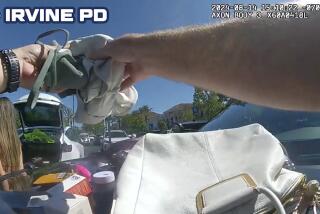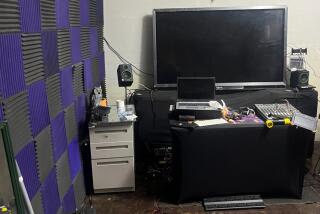UCI Asks for Return of Stolen NASA Ozone Research Data : Appeal: Vital information was taken during apparent burglary of geosciences department. Reward is offered.
UC Irvine officials issued a rare public appeal Tuesday for the return--no questions asked--of vital research on the Earth’s ozone layer, information stolen during an apparent burglary of the university’s geosciences department.
Geosciences department chairman Ralph J. Cicerone offered a $1,000 reward for the return of the data, which was stored on a laptop computer and on five computer disks taken in the break-in last weekend. Flyers spread across campus Tuesday asked anyone with the disks or information on their whereabouts to call (714) 725-2987.
“No questions will be asked,” the flyer says.
The computer and the disks were among $8,000 worth of equipment stolen from a locked office on the second floor of the university’s Physical Sciences Research Building. Another $4,050 in computer equipment and a short-wave radio were taken from a second locked office on the same floor, apparently in the same raid, campus police said.
“At this point, all we care about is getting the information back,” Cicerone said. “In fact, if we just get the disks back, we don’t care so much about the computer.”
Cicerone said such a theft of two sets of research information is unheard of at major universities.
Like many other universities and private companies, UCI has been plagued for years by computer thieves. But the pace appears to have stepped up in recent months.
“We have had at least one a week since last November,” said Dennis Powers, UCI’s assistant chief of police.
But unlike the rash of other recent computer thefts, there was no sign of forced entry to either the building, the second-floor geosciences wing or to either of the two offices hit by thieves last weekend.
“This case is not typical of the majority of our computer thefts,” Powers said. “This area had other computers they didn’t take.”
Police believe that the thieves used keys to gain entry to both the locked building and the locked offices. The thefts occurred sometime between 11 p.m. Saturday, when some geosciences’ faculty members left for the night, and 9 a.m. Easter Sunday. It was then that Prof. William S. Reeburgh discovered that a Macintosh laptop computer, a printer and a short-wave radio were missing from his office.
The theft of the equipment containing NASA research analysis from an office two doors away was not discovered until later the same day.
NASA’s raw data, collected on four separate missions from 1987 through March, 1992, at a cost of about $50 million, still exists in archives at Harvard University. What is missing, said Darin W. Toohey, UCI assistant professor, is an interpretive analysis that he has been working on for six years and with the help of a Harvard graduate student for the last three.
Toohey’s work and that of Harvard chemistry Ph.D. candidate Linnea Avallone examined reactive chlorine and bromine compounds found over both the North and South poles. Both chemical compounds, found in refrigerants such as Freon and Halon gases, and in certain fumigants, have been connected to the thinning of the Earth’s protective ozone shield.
The researchers said some of the 75 or so scientists working in 14 separate groups on the National Aeronautics and Space Administration atmospheric project have been depending on the data for their own work.
“This will certainly slow down all of our analysis because we’ll have to go back and start over,” said Avallone, 26, of Connecticut. “We do have another copy of the raw data. But what’s most devastating is that . . . it will take us another three years of analysis to get to where we were before the data was stolen.”
Toohey was more optimistic, saying it may be possible to reconstruct much of it in two years or less. But that is valuable time better spent on new research.
“Why do I have to spend another year or two of my time just to get back to where we were,” said the 32-year-old chemist, who came to UCI from Harvard in April, 1991. He is originally from La Habra.
“The stupid thing here is that we would have made them a copy,” he added. “This is NASA data that belongs to the public.”
However, neither the scientists nor campus police believe research espionage was behind the theft. Toohey said the data would be an undecipherable series of dots, zeros and other signs readable only with the help of special computer software.
The missing equipment was described as a Tandon brand laptop and five computer disks in white and gray boxes. The five disk boxes were labeled “AASE II Raw Data,” “AASE II Spread sheets and Exchange,” “AAOE-AASE Raw Data,” “AAOE/AASE Spreadsheets,” and “Computer Backup.”
The theft is likely to spur researchers to keep backup copies of their work stored under lock and key.
Avallone said she left both the computer and the disks on top of her desk, thinking there was adequate security with the locks on her door and those of the department wing and the building itself.
“I’m going to lock up my backup disks now, that’s for sure,” she said. “But I guess I’m still amazed that someone would consider disks valuable commodities.”
Ironically, the researchers had decided last week to make extra copies of the work beginning Monday. “But we were broken into Saturday night,” Toohey said.
Avallone, who is a month away from completing her doctoral thesis based upon the NASA research, pleaded with those who took the material to return it.
“Please give it back,” she said. “It means more to us than it possibly could to anybody else.”
More to Read
Sign up for Essential California
The most important California stories and recommendations in your inbox every morning.
You may occasionally receive promotional content from the Los Angeles Times.










